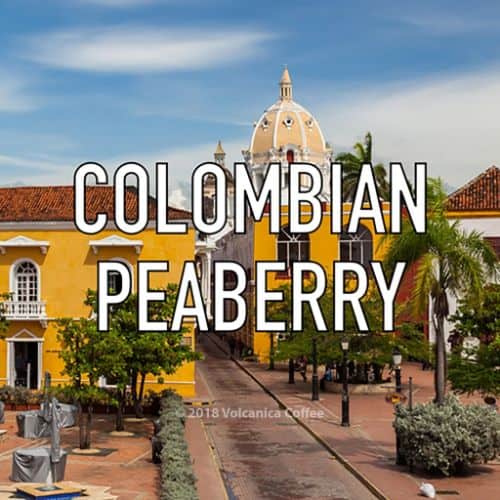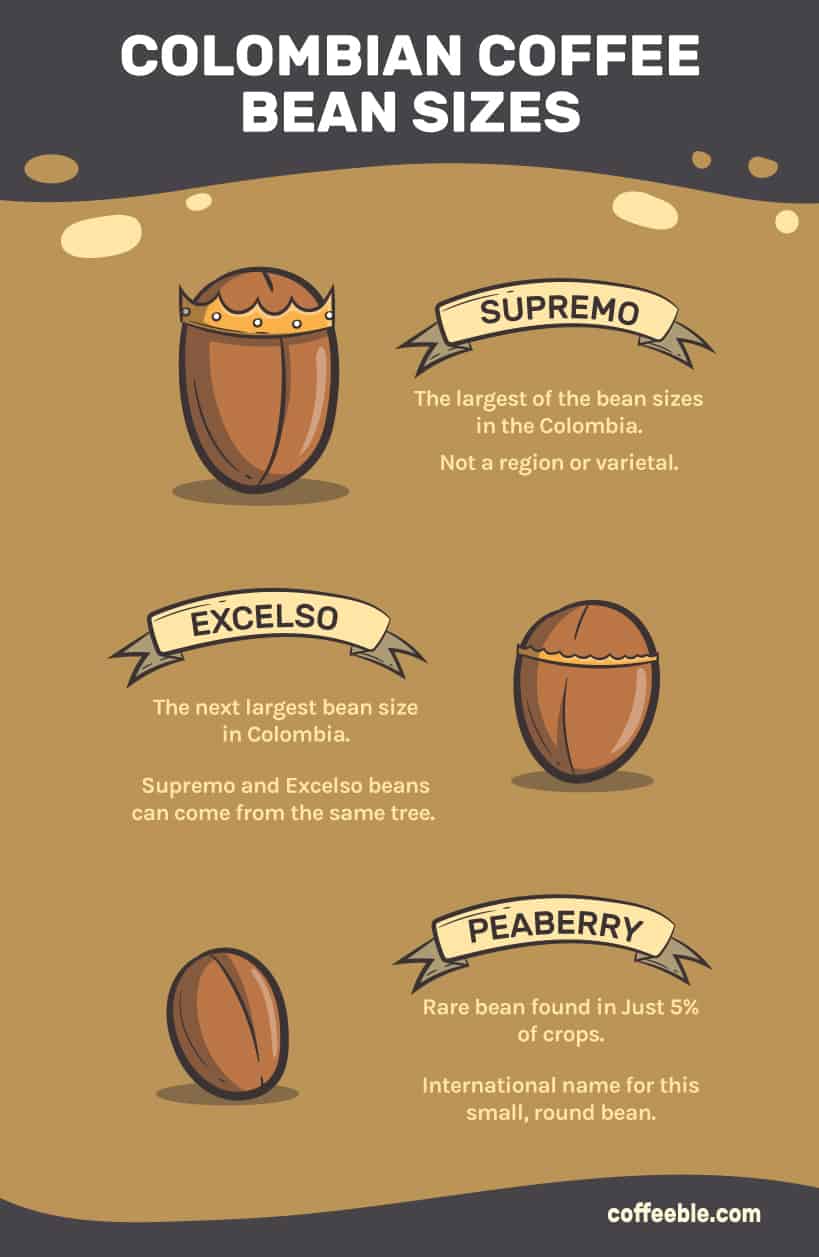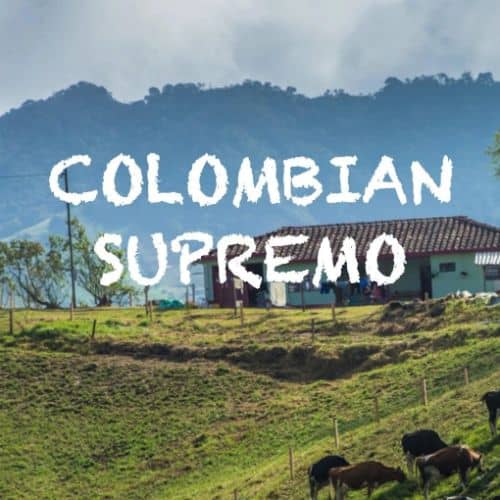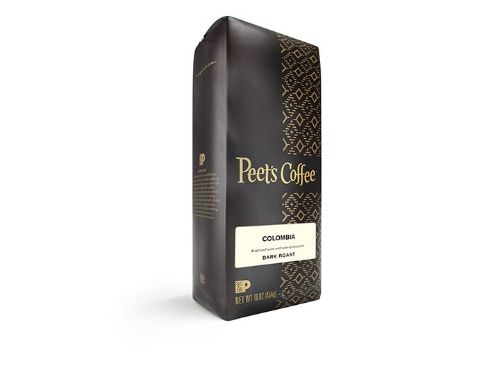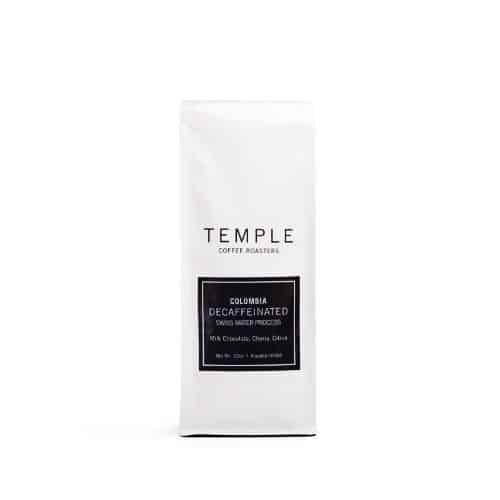Volcanica Colombian Peaberry
Hand-picked from farms at 5,900 feet
Fully wash processed to highlight the beans’ natural flavors
Unique peaberry bean that occurs in just 5% of any crop
What to look for when buying Colombian coffee
The Colombian coffee industry is one of the largest worldwide. Though it does have a reputation for some great quality beans, there is also plenty of low-quality coffee that takes advantage of the Colombia brand. When you’re shopping for the best Colombian coffee brands, here are a few things to look for.
Colombia’s coffee growing regions
Colombia is blessed with a natural environment that makes it ideal for growing some of the world’s best coffee. It’s found in the coffee belt, close to the equator. This ensures a tropical climate and high mountains close to the coast. Colombian coffee beans are generally prized for their aromatic flavors with pronounced acidity that makes them a favorite among coffee lovers.
Take your time to appreciate acidity, since it’s one of the most valued aspects of specialty coffee.
Flavors of Bogota
I cannot but agree with Flavors of Bogota: you must appreciate the acidity in specialty coffee.
The country has 22 different coffee growing regions. The beans’ characteristics vary from region to region, but they are grouped into three main areas in general.
The north zone produces the least amount of coffee, but it’s where you’ll find many of the country’s organic farms. The climate here is somewhat drier than other parts, and coffee is grown at lower altitudes, resulting in beans with a good body that are lower in acidity (1). Expect flavors like chocolate from these beans. The best-known region here is Santander.
In the central zone, you will find the critical Colombian coffee growers. The coffee triangle (also known as Colombia’s coffee belt) comprises Caldas, Quinido, and Risiralda. Not only is this the most productive area, but it’s also famed for having some of the best beans. This area produces beans with a balance of acidity and body, with flavor profiles that are fruity and aromatic. You may also see they market coffee from this as MAM: short for the cities of Medellin, Armenia, and Manizales (2).
The south of the country sits closer to the equator, and farms are at much higher altitudes.
Beans produced in this are known for having high acidity levels, with complex flavors in the cup. Here you’ll find the Huila region, which is becoming one of the country’s most prominent producing areas in terms of quantity and quality. Huila was awarded a denomination of origin in 2013 (3).
Colombian coffee production
It’s not just where your coffee comes from that determines how it will taste. While the growing conditions and varietal provide the flavors intrinsic to the bean, what happens next will change how these flavors develop.
Colombian coffee is predominately processed using the washed or “wet” method. After they harvest the coffee, they remove the beans’ cherries in a procedure known as de-pulping. This means that they dry in a thoroughly “washed” state. This contrasts with natural or “dry” processing, where the fruit is left intact for the drying process.
The downside to this method is that, as you might guess from the name, it uses a lot of water, but there are upsides too. It gives a more consistent result than naturally processed beans, which can sometimes produce unpleasant fermenting flavors (4).
The other benefit is how it affects the taste.
I often feel like you’re going to have a more delicate body from a washed.
Sam Lewontin, Everyman Espresso
Washed beans retain more of their natural flavor, rather than that of the fruit, and for this reason, can be highly regarded by coffee connoisseurs. With washed beans, you can get a better feel for regional differences. The beans will have a more delicate flavor but still complex, with more pronounced acidity and floral aromas.
What is a Supremo bean?
Alongside the region or roast on a Colombian coffee label, you might have seen terms like Supremo or Excelso. So what do these mean? The Colombian coffee industry has its terminology for grading coffee, the method of sorting beans according to their size.
The Supremo bean is the largest and, therefore, the most prized, related to the Superior or AA/A classification in other countries. Excelso is the next largest, comparable to Superior/Segundo or A/B beans.
Colombia does not have terms for the smaller beans known as terceras or C beans elsewhere (5).
The Best Colombian Coffee Brands in 2024
| Product | Details | Button | |
|---|---|---|---|
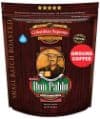
|
Don Pablo Colombian Supremo |
|
 SEE ON AMAZON
SEE ON AMAZON
|
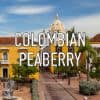
|
Volcanica Colombian Peaberry |
|
Click to Check Price |
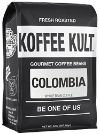
|
Koffee Kult Huila Coffee |
|
 SEE ON AMAZON
SEE ON AMAZON
|
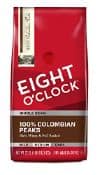
|
Eight O’Clock Coffee 100% Colombian Peaks |
|
 SEE ON AMAZON
SEE ON AMAZON
|
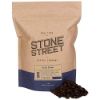
|
Stone Street Coffee Cold Brew Reserve Colombian Supremo Whole Bean Coffee |
|
 SEE ON AMAZON
SEE ON AMAZON
|
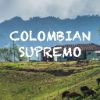
|
Volcanica Colombian Supremo Andeano Estate |
|
CLICK TO CHECK PRICE |

|
Peet’s Colombian Coffee |
|
CLICK TO CHECK PRICE |
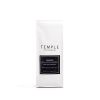
|
Temple Decaffeinated Colombia San Jose |
|
CLICK TO CHECK PRICE |

- Medium-Dark Roast
- Citrus, chocolate, nuts
- GMO-free

- Medium Roast
- Fruit, cocoa, cinnamon
- Kosher

- Medium Roast
- Cinnamon
- No certifications

- Medium Roast
- Wine tasting note
- Kosher

- Dark roast
- Chocolate
- Kosher

- Medium Roast
- Chocolate, caramel, orange
- Fair trade, Rainforest Alliance, Kosher

- Dark Roast
- Stone fruit
- No certifications

- Medium-dark roast
- Chocolate, citrus, cherry
- No certifiactions
Now that you know a bit about what makes Colombian coffee so unique, it’s time to apply it to selecting your beans. Here are eight of the best Colombian coffee brands that we’re sure you’ll love.
This list only covers fresh roasted whole beans, but head over to our guide to instant coffees if you’re looking for a quick coffee option.
1. Don Pablo Colombian Supremo – Best Low Acid
Specifications
Roast: Medium-Dark
- Tasting notes: Citrus, chocolate, nuts
- Certifications: GMO-free
- Best for: Drip brewing
Don Pablo started life in 1989, specializing in Colombian coffee. The company has expanded to both source beans from other Latin American parts and some of the world’s best growing regions. Don Pablo has its farms in Colombia, where they can monitor their beans’ high quality.
Regardless of the region, they have strict criteria for all the coffee beans they source and grow. They’re all 100% Arabica beans and shade-grown at high altitudes. To ensure freshness, they roast coffee, using multiple small-batch roasters.
These Colombian Supremo coffee beans have been roasted to a medium-dark stage that adds a hint of toastiness to the flavor profile. In the cup, it has a medium body with low acid and a smooth, sweet finish. Expect to taste notes of citrus, with a chocolate and walnut finish.
If you’d like to enjoy Don Pablo’s Colombian Supremo beans at a later hour, they’re also available as a water-processed decaf – or check our recommendation for best decaf below.
2. Volcanica Colombian Peaberry – Best Overall
Specifications
Roast: Medium
- Tasting notes: Fruit, cocoa, cinnamon
- Certifications: Kosher
- Best for: French press
Regardless of whether you grow Robusta or Arabica coffee, all crops of all varietals will produce what’s known as peaberry beans. Most coffee cherries make two flat beans, but only one round seed develops in the case of peaberries.
Due to their shape, peaberry beans are said to roast more evenly, creating a smoother coffee cup. They are also said to have a more concentrated flavor and sweetness, as the developing bean did not have to share any of the nutrients (6).
This Colombian coffee has been harvested at altitudes of up to 5,900 ft, enhancing the natural density of peaberry beans. Dense coffees require a longer extraction time to get the most flavor out of the beans, so Volcanica Colombia Peaberry is perfect for coffee presses or other slower brewing methods.
Once brewed, you will be greeted by a flavor profile that includes traits of both Colombian and peaberry beans. Expect a strong floral aroma and full-body that’s balanced with medium acidity. In the cup, you’ll have notes of fruit, cocoa, and cinnamon. Volcanica Coffee’s commitment to quality is what makes this our pick for one of the best Colombian coffees.
3. Koffee Kult Huila Coffee – Best Medium Roast
Specifications
Roast: Medium
- Tasting notes: Cinnamon
- Certifications: none specified
- Best for: Pour over
Though this particular coffee doesn’t bear organic certification, Koffee Kult only sources its beans from USDA certified organic farms in some of the world’s best coffee growing regions. The company has committed to sustainability on both an environmental and social level. Koffee Kult sources more from than 650 coffee growers worldwide but only works with those who can prove that women are paid equally and do not use unethical child labor.
These Colombian coffee beans have been sourced from the Huila region, which, along with Cauca and Narino, forms an area that people are calling Colombia’s “new coffee triangle” (7). Huila is warm and mountainous, with fertile soil thanks to the nearby Nevado del Huila volcano. Colombian coffees from Huila are characterized by a bold body and medium acidity, with sugary flavors and aromas.
The medium roast makes these great beans for pour over brewing. They produce a coffee with bold flavors, hints of cinnamon, and a clean, sweet finish. All Koffee Kult beans are roasted to order.
4. Eight O’Clock Coffee 100% Colombian Peaks – Budget Pick
Specifications
Roast: Medium
- Tasting notes: Wine
- Certifications: Kosher
- Best for: Drip brewing
This affordable option for quality Colombian coffee is an ideal breakfast option. Make yourself a drip brew, and you’ll get a rich and full-bodied coffee that will pair well with sweet or savory food—flavors and sweet with notes of wine, but with a hint of chocolate bitterness in the aftertaste.
Eight O’Clock Coffee has been around since 1859. For most of these 150 years, the company focused on quality whole bean blends to suit the American palette. It wasn’t until 2003 that they introduced ground coffee followed a few years later by flavored beans.
The company’s focus is not all consumer-facing, however. Eight O’Clock Coffee is what they call Rooted in Responsibility, which is their commitment to improving the lives of the coffee farmers they work with and protecting the environment. It also partners with the International Women’s Coffee Alliance (IWCA) to empower women working in the coffee industry.
5. Stone Street Coffee Cold Brew Reserve Colombian Supremo Whole Bean Coffee – Best for Cold Brew
Specifications
Roast: Dark roast
- Tasting notes: Chocolate
- Certifications: Kosher
- Best for: Cold brew
Simply put, Stone Street Coffee makes amazing cold brew beans. The company does a line of regular single-origin and blends, but their cold brew range goes far beyond this Colombian selection. You can find flavors like blueberry, chocolate, or French vanilla, all roasted for the ideal cold coffee extraction.
The roast level for cold brew is down to personal preference, but many beans sold with a cold brew label are at the darker end of the scale. This is because the cold extraction process highlights the nutty or chocolatey flavors of dark roasts rather than the floral aromatics of lightly roasted coffee (8). Stone Street’s Colombian Supremo beans are true to type, with low acidity, a sweet, rich flavor, and chocolate notes.
If you’re looking for the fresh acidity that this country is known for, Stone Street also makes a light roasted Colombian Supremo coffee.
6. Volcanica Colombian Supremo Andeano Estate – Best Single Origin
Specifications
Roast: Medium
- Tasting notes: Chocolate, caramel, orange
- Certifications: Fair trade, Rainforest Alliance, Kosher
- Best for: Pour over
These single-origin beans have been harvested from the Andeano Estate and found high on the Andes’ slopes. The altitude adds acidity to the beans, while the rich, volcanic ash soil creates a complex flavor profile.
As with most roasters of Colombian coffee, Volcanica has processed these by using the washed method. This allows you to get the full taste of the bean and experience this particular climate’s specifics. You’ll get a rich, full-bodied coffee with notes of chocolate, caramel, and orange.
Volcanica consistently produces high-quality coffee from some of the best growing regions in the world. If you’ve ever wanted to try these beans from Kona, Hawaii or get your hands on some certified Jamaica Blue Mountain coffee, this is the place to go. All Volcanica coffee is fresh roasted daily to ensure you get the best beans possible.
7. Peet’s Colombia – Best Dark Roast
Specifications
Roast: Dark
- Tasting notes: Stone fruit
- Certifications: none specified
- Best for: Pour over
Peet’s single origin beans are grown in the famed region of Huila. Nestled alongside the country’s second-highest peak, which also happens to be a volcano, it ticks all the boxes for an ideal climate for coffee growing. And in fact, Huila regularly produces Cup of Excellence-winning beans.
These Colombian coffee beans have been given a dark roast. Such a roast level gives them a full body and tones down some of the acidity. However, the flavor remains bright and clean, with sweet flavors of stone fruit on the palette. This coffee is ideal for pour-over brewing as a single origin, highlighting the nuances of the beans’ flavors.
All Peet’s coffees are responsibly sourced using their Coffee Verification Program. This sets standards for social, environmental, and economic criteria for the farmers. Peet’s coffees are roasted by hand and stamped with the roast date, so you know exactly how fresh your coffee is.
8. Temple Decaffeinated Colombia San Jose – Best Decaf
Specifications
Roast: Medium-dark
- Tasting notes: Chocolate, citrus, cherry
- Certifications: none specified
- Best for: Espresso
Starting as a simple coffee shop selling excellent brews, Temple has now expanded to include seven coffee houses and a roastery. However, the idea is still the same: to provide customers with fantastic coffee worldwide.
Temple works with a Farm to Cup sourcing model that ensures farmers are regularly paid above fair-trade prices for their beans. Priority is given to coffee growers who actively reduce their impact on the environment using shade management and water conservation.
Swiss water processing is the preferred and most natural method of removing the caffeine from coffee beans, as it avoids the use of chemicals completely. These Colombian coffee beans will give you all the flavor of the Cauca region, without the jitters. As a medium-dark roast, these make excellent espresso coffee beans. You’ll get a medium-bodied brew with a rich, sweet finish, highlighted by tastes of cherry, chocolate, and a hint of citrus.
The Verdict
If you choose any one of our recommendations, you’ll be able to experience some of the best coffee Colombia has to offer.
However, if you’re looking for something exceptional, start with the Volcanica Colombian Peaberry. Beans grown in high altitudes are often considered better quality, and these beans represent a unique 5% of this crop.
FAQs
Colombia’s coffee is so good due to the climate and the processing. The growing conditions are perfect for coffee, being tropical and mountainous. Due to the steep slopes, coffee beans have to be harvested by hand, which retains the harvest quality.
Colombian coffee is not the strongest. There is a misconception that Colombian coffee is stronger than coffee from other countries, but this is not true. Colombia produces exclusively Arabica coffee, which tends to be not as strong as the Robusta bean you can find in other parts of the world.
Colombians drink the so-called tinto. Loosely translated as “inky water”, it’s a weaker coffee than what you may be used to, consumed in small quantities but with plenty of sugar. You can make it by merely boiling grounds in a saucepan of water, though filters are sometimes used.
- Molina-Ospina, A. (2017, October 26). A Roaster’s Guide to The Coffee-Producing Regions of Colombia. Retrieved from https://perfectdailygrind.com/2017/10/a-roasters-guide-to-the-coffee-producing-regions-of-colombia/
- Nie, F. (2019, June 22). Coffees from Colombia. Retrieved from https://worldtravelercoffee.com/blogs/news/coffees-from-colombia
- Regional Denomination of Origin. (2020, February 21). Retrieved from https://www.cafedecolombia.com/particulares/regional-denomination-of-origin/?lang=en
- Sherfey, J. (2016, April 08). How Coffee Processing Affects the Flavor in Your Cup. Retrieved from https://www.eater.com/coffee-tea/2016/4/8/11392668/coffee-beans-roasting-processing-natural-washed-honey
- Molina-Ospina, A. (2018, November 14). Kenya AA, Colombia Supremo: Understanding Coffee Grading. Retrieved from https://perfectdailygrind.com/2018/11/kenya-aa-colombia-supremo-understanding-coffee-grading/
- Raquel Gonzalez Cauca FW. (n.d.). Retrieved December 27, 2020 from https://sucafina.com/emea/offerings/raquel-gonzalez-cauca-fw
- Martin, T. (2016, September 29). What are the best beans to use for cold brew coffee? Retrieved from https://www.cnet.com/how-to/what-type-of-coffee-should-you-use-for-cold-brew/

